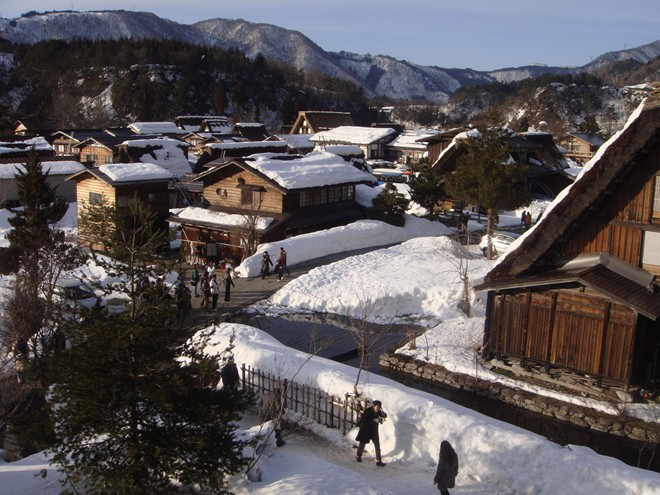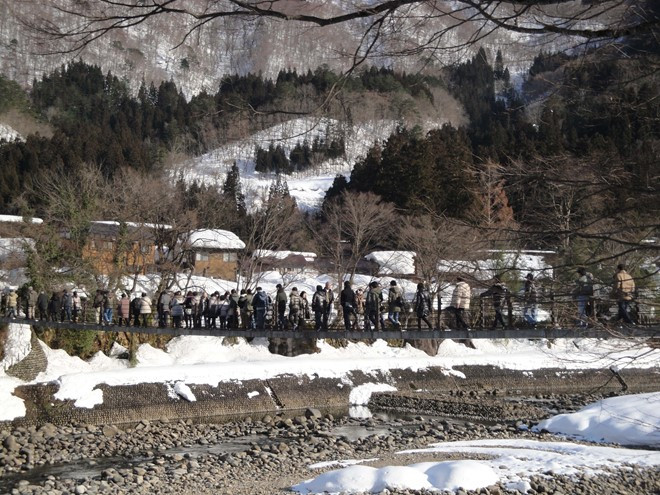The most original ancient village of Phu Tang
Shirakawago in central Gifu Prefecture is one of the two most unique ancient villages in Japan. The village has been recognized as a world heritage site by UNESCO since 1995. With the architecture of a sloping cottage, Gassho zukuri's hands, like the prayer houses, the village has 114 old houses, the oldest house of the village. age over 400 years.
Shirakawago is Japanese for meaning white , the village of white rivers. Despite the economic downturn, earthquakes, the Shirakawa-go disaster seems to stand away from the time breath, there, as if time stands still, to look, to watch, to recharge life energy. Shirakawa-go roofs are like prayers, both religious and religious, to protect the rage of nature and snow storms.

A corner of Shirakawago ancient village.
We visited the village on the coldest days of Japan, the outdoor temperature of 4-5 degrees Celsius. Tourists of Gifu Prefecture said that there were negative 10 degrees Celsius here, very cold. White snow-covered triangular houses create an ancient painting in Shirakawago village. At an altitude of 500m above sea level, the road to the village has to go through a wire bridge 107m long called Deaibasi - Bridge of Grace. People here said that the bridge is also one of the symbols of the village, wishing to always be surrounded and harmonized.

Tourists go through graceful bridges.
Visiting each house, we clearly see the sophistication of the people here. The cottage Gassho zukuri is made of wood, with thatched roof with a thickness of 50cm. The house is characterized by black ebony made from many types of wood. Every resident here has a few hills, so choosing a timber to build a house is not difficult. In order to complete this house, it took people several months. The house is designed in a triangle shape, in the middle of the first floor there is a red firewood stove for both heating and wood making. From the second floor onwards, the floor between the houses has gaps so that smoke from the 1st floor escapes.
In each old house, people often spend a floor to store farming tools, make use of space on the house to store and raise silkworms. But now these tools are only for visitors, 80% of the ancient villagers have abandoned their agricultural jobs and switched to service and tourism. Currently some households are still growing rice but to protect the landscape of the village because the rice field is also part of the world cultural heritage. Rice and vegetables are grown just enough for the family to eat during the year.

Old house 200 years old.
The owner of the 200-year-old old house introduced us to a kitchen on the first floor of an old house that is considered a sumptuous room. It was both a living room, a common room and even a dining room.
We were at the reunion room of the 49-year-old Oizumi Shingo family in an old house for 200 years. In the warm fire, he shared with us about the culture, lifestyle and way of life of farmers in the village.

Next to the firewood kitchen chatting with the owner of Oizumi.
A prominent feature in the old houses is not to use nails on the walls. Instead they use ropes or jute rope. Ancient houses here are supported by the local in conservation.
The roof is made very featureless, often when a house fixes the roof of the surrounding people in the village to help. Each roof is 30-40 years old. Making roofs very expensive, houses that change roofs will be supported by local authorities to redo, the household heads only lose 10% of that amount.

Tourists visit the village.
People here know how to attract tourists with traditional festivals. According to the annual rice culture in the ancient village Shirakawago celebrates Dobudo festival.
This is the biggest festival of the year that attracts thousands of tourists to visit. Mr. Oizumi said it was a festival to drink rice wine to celebrate the harvest and prayed for the gods to cover it so that the villagers could harvest well in the next crop.
In the months of January and February on Saturday evenings, every year, the village organizes electric lighting in all old houses, creating a festival of light to attract tourists.
Luckily we arrived on the Saturday afternoon of February, the day when tourists came and witnessed the preparation of the light festival of families.
Every year, it welcomes nearly 2 million visitors, of which the number of foreign tourists is increasing.




- Traces the 2,300-year-old village
- Devotees head to the ancient village in Turkey
- 15 villages as beautiful as fairy tales
- Discover the village over 1000 years old in the US national park
- Belgium discovered traces of an ancient village at a construction site
- 600-year-old citadel in Xi'an
- China discovered the ancient citadel of the Tang Dynasty built by Cao Bien
- Thousand-year sphinx statue in the tomb of Tang Dynasty
- Climate change makes Tang Dynasty and Maya civilization collapse
- Discover ancient wells near Ho's citadel
- Discover the ancient village of Eskimo under the ice melting in the Arctic
- The village no one dared to mention the name for fear
 'Fine laughs' - Scary and painful torture in ancient times
'Fine laughs' - Scary and painful torture in ancient times The sequence of numbers 142857 of the Egyptian pyramids is known as the strangest number in the world - Why?
The sequence of numbers 142857 of the Egyptian pyramids is known as the strangest number in the world - Why? History of the iron
History of the iron What is alum?
What is alum?